Nestled on Italy’s boot heel, Puglia is a treasure trove of experiences, boasting an array of sights that promise an unforgettable journey. In this guide, we’re delving deep into the heart of this enchanting region to spotlight the 10 best places in Puglia that you won’t want to miss.
Crafting this list wasn’t an overnight task; it was a labor of love, experiences and research to find the best places in Puglia that both encapsulate this region and also show off how unique Puglia is compared to the more famous Tuscany and other regions in Italy. So many people miss exploring Italy’s boot heel, and I want to show you all the best things to do in Puglia so it’s top of your list!
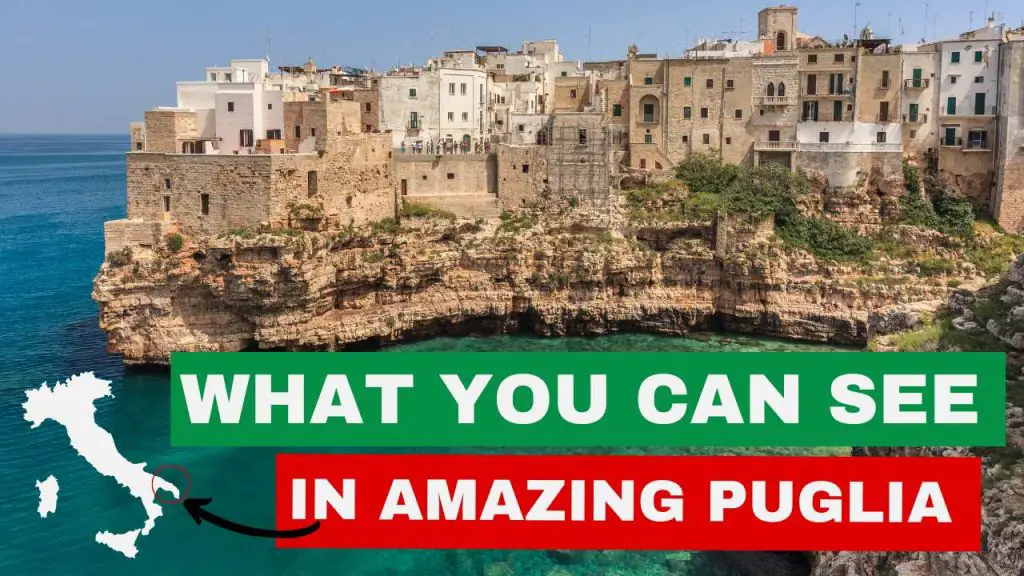
Puglia is more than just a destination; it’s an experience that stays with you. From the whitewashed streets of Ostuni to the majestic trulli of Alberobello, the region’s unique architecture tells a story as rich as its history.
But Puglia isn’t just for history buffs; it’s a haven for foodies, nature lovers, and beachgoers alike. With this guide, we invite you on a journey to discover the olives groves, crystal-clear waters, and culinary masterpieces that define Puglia.
So, whether you’re planning your next Italian adventure or just daydreaming about distant shores, join us as we explore the charm, beauty, and unforgettable experiences that Puglia has to offer. Through this article, we aim to provide a simple yet comprehensive guide to this spectacular region, ensuring that when you visit, you can dive straight into the heart of what makes Puglia truly magical.
Let’s start!
Spectacular Places To Visit In Puglia
1. Alberobello
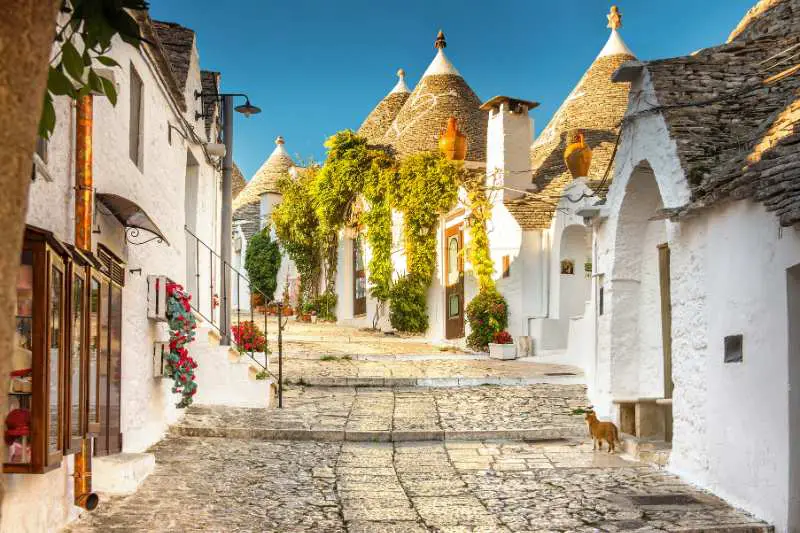
Alberobello is a captivating town in Puglia, Italy, distinguished by its trulli – whitewashed stone huts with conical roofs that are unique to the region. This architectural style dates back to the 14th century and was originally designed as a practical solution to evade taxes on new settlements under the Kingdom of Naples.
The trulli are ingeniously constructed without mortar, allowing them to be dismantled quickly when inspectors were in the area. Beyond its fascinating history, Alberobello offers visitors a magical atmosphere that feels like stepping into a fairy tale. Walking through the narrow streets lined with trulli, now housing shops, restaurants, and museums, provides a unique window into the innovative spirit of past residents.
Its distinctive landscape and cultural significance have earned Alberobello a rightful place as a UNESCO World Heritage site. The combination of historical intrigue, architectural uniqueness, and vibrant community makes Alberobello an unmissable destination in Puglia.
2. Polignano a Mare
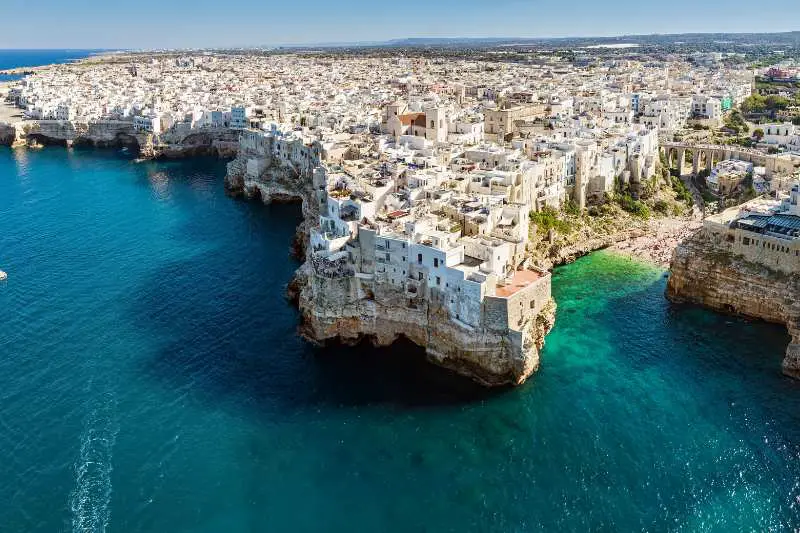
Polignano a Mare is a gem on the Adriatic coast, famed for its dramatic cliffside landscapes, ancient caves carved by the sea, and crystal-clear waters. The town itself is rich in history, with origins dating back to the 4th century BC when it was a crucial trading hub for the Greeks.
Its enchanting old town, perched atop limestone cliffs, offers narrow streets and charming piazzas to explore, with stunning sea views at every turn. The most iconic spot in Polignano a Mare is perhaps the Lama Monachile beach, nestled between rugged cliffs with a Roman bridge towering above.
The combination of natural beauty, historical depth, and the vibrant culinary scene, including the renowned cave restaurant Grotta Palazzese, makes it a destination that captures the essence of the Italian coastal experience. Visitors are not just treated to breathtaking views but are also immersed in a culture that celebrates life, the sea, and gastronomy, making it a must-visit locale in Puglia.
3. Lecce

Lecce is a city that stands out for its Baroque architectural masterpieces, with elaborate facades and interiors that showcase the skill and creativity of its craftsmen, particularly in the use of the local Lecce stone. This soft, malleable limestone has been sculpted into intricate designs that adorn churches, palaces, and public buildings, earning the city its nickname as the “Florence of the South.”
However, Lecce’s appeal goes beyond its stunning Baroque artistry. It is a city steeped in history, with roots tracing back to the time of the Messapians before becoming an important center under Roman, then Norman rule. Today, Lecce remains a vibrant cultural hub, with lively squares, a thriving cafe culture, and a dynamic arts scene.
The city also serves as a gateway to the Salento peninsula, making it an ideal base for exploring the broader region. Lecce’s combination of historical depth, architectural beauty, and cultural vitality offers a quintessentially Italian experience that is both enriching and enchanting.
4. Ostuni

Ostuni, known affectionately as the “White City,” is distinguished by its dazzling white-painted architecture that gleams under the Southern Italian sun. This visual spectacle is not only beautiful but also has practical origins, with white lime paint historically used for its disinfectant properties.
Ostuni’s charm is amplified by its position atop a hill, offering panoramic views of the Adriatic Sea and surrounding olive groves. The city’s maze of narrow streets, staircases, and archways invite exploration, leading visitors to discover hidden courtyards, quaint cafes, and artisan shops.
Ostuni’s rich history, visible in its medieval walls and Gothic cathedral, adds layers of intrigue to its physical beauty. Its strategic location also makes it a perfect starting point for excursions to nearby beaches and natural reserves.
Ostuni represents the intersection of aesthetic beauty, historical architecture, and the natural allure of the Puglian landscape, making it an essential stop for travelers seeking to fully experience the region’s diversity.
5. Castel del Monte

Castel del Monte stands as a testament to the architectural ambition and enigmatic vision of its founder, Emperor Frederick II. Built in the 13th century, this UNESCO World Heritage site is unlike any other medieval fortress, characterized by its unique octagonal shape and precise geometric and astronomical alignments.
Each of the castle’s eight sides and the eight rooms on each of its two floors align with the points of the compass, suggesting a blend of earthly power and celestial wisdom. The design incorporates elements from Islamic, Gothic, and Classical traditions, reflecting the eclectic influences of Frederick’s court.
Its purpose remains a mystery, serving neither as a formidable fortress nor a lavish residence. Instead, Castel del Monte captivates the imagination as a monument to human curiosity and the universal search for knowledge.
Its isolated location on a hill in the Apulian countryside enhances its mystique, inviting visitors to ponder the legacy of one of history’s most intriguing rulers while enjoying sweeping views of the surrounding landscape.
6. Gargano National Park
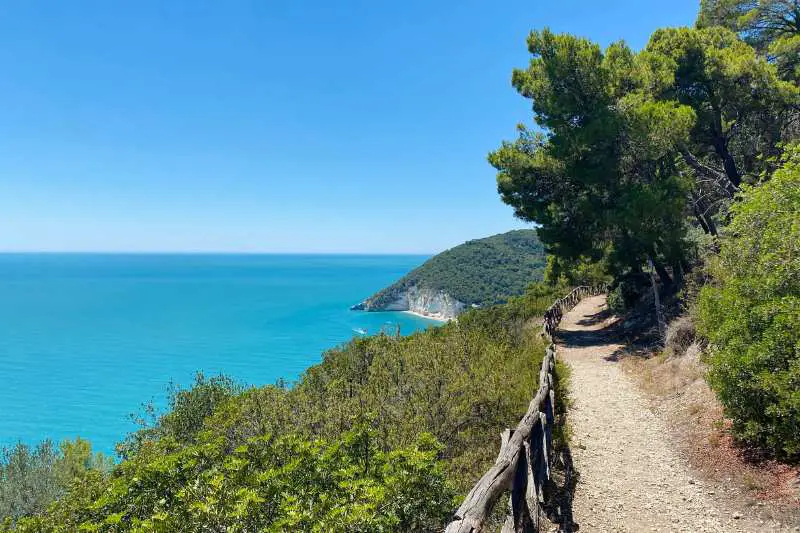
Gargano National Park offers a dramatically different side of Puglia, showcasing the region’s natural diversity with its rugged coastline, ancient forests, and mountainous terrain. The park is a haven for outdoor enthusiasts, offering a plethora of activities from hiking and cycling to bird watching and cave exploration.
The Umbra Forest, a dense woodland within the park, is particularly notable for its biodiversity, including centuries-old beech trees, orchids, and a variety of wildlife. The coastline is dotted with picturesque bays, sandy beaches, and towering sea cliffs, providing countless opportunities for water sports and relaxation.
The Tremiti Islands, part of the national park, are a marine reserve known for their crystal-clear waters and rich marine life, ideal for snorkeling and diving.
Gargano National Park is not just a natural paradise but also a place of spiritual significance, with ancient sanctuaries and pilgrimage sites nestled in its landscapes. Its combination of natural beauty, outdoor adventure, and cultural depth makes it a compelling destination for those looking to connect with the wild heart of Puglia.
7. Bari

Bari, Puglia’s capital city, is a vibrant urban center that effortlessly combines rich historical heritage with a lively contemporary culture. The city’s old town, Barivecchia, is a dense maze of narrow streets, where ancient traditions are kept alive by the local community.
Notable landmarks include the Basilica di San Nicola, a key pilgrimage site that houses the relics of Saint Nicholas and exemplifies Puglia’s Romanesque architecture. Beyond its historical and religious significance, Bari offers modern attractions, including a dynamic food scene where visitors can sample local specialties like orecchiette pasta on the streets of the old town.
The city’s strategic location on the Adriatic Sea has shaped its history as a trading port, contributing to its multicultural atmosphere. Bari serves as a gateway to the region, with excellent transport links to other destinations in Puglia and beyond.
Its blend of old-world charm and modern energy, coupled with its role as a cultural and economic hub, makes Bari an essential inclusion on any itinerary through Puglia.
8. Taranto

Taranto, often overlooked by tourists, holds a significant place in both ancient and modern history. Known as the “City of Two Seas,” it is situated between the Mar Grande and Mar Piccolo, providing strategic importance since its founding by the Spartans in the 8th century BC.
Taranto’s rich historical tapestry is visible in its archaeological sites, including the Spartan Museum and majestic Aragonese Castle, which highlight the city’s layered past from Greek colony to medieval stronghold.
In addition to its historical sites, Taranto is reinventing itself as a cultural destination, with initiatives aimed at preserving its industrial heritage while promoting contemporary art and cuisine. The city’s unique blend of classical history, industrial legacy, and evolving identity offers a deeper understanding of the complexities of Southern Italy.
Taranto’s commitment to revitalization, combined with its ancient roots and the natural beauty of its surrounding seas, makes it a fascinating place for those interested in the convergence of past and future.
9. Valle d’Itria
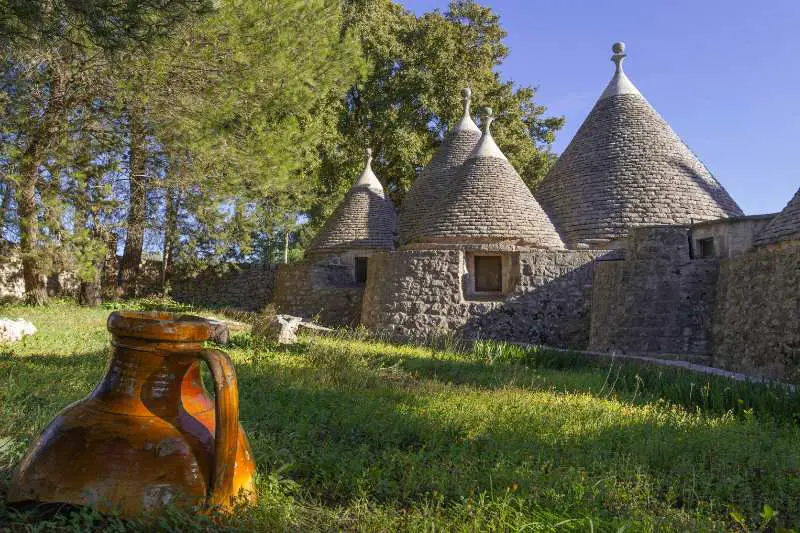
Valle d’Itria is celebrated for its idyllic landscape, dotted with the iconic trulli, vineyards, and ancient olive groves. This picturesque valley spans several charming towns, including Martina Franca, Locorotondo, and Cisternino, each offering a unique glimpse into Puglia’s cultural and architectural heritage.
Martina Franca is known for its elegant Baroque and Rococo buildings, while Locorotondo and Cisternino feature whitewashed houses and panoramic views of the rolling countryside.
The valley is not only a feast for the eyes but also for the palate, with a rich culinary tradition that includes locally produced wines and olive oils.
Valle d’Itria’s peaceful countryside, combined with its architectural beauty and gastronomic excellence, offers a serene retreat into a world where time moves slowly, and life’s pleasures are savored.
10. Salento Peninsula

The Salento Peninsula marks the southernmost tip of Puglia, stretching into the Ionian and Adriatic seas. Known for its crystalline waters, golden beaches, and vibrant cultural scene, Salento is a microcosm of Mediterranean beauty and traditions.
The region boasts a rich tapestry of history, evidenced by its Greco-Roman ruins, Byzantine churches, and Baroque towns like Lecce. Salento’s unique identity is also reflected in its music and dance, particularly the pizzica, which is rooted in local folklore and rituals.
The peninsula’s culinary offerings, including seafood specialties and distinctive wines like Primitivo and Negroamaro, highlight the bounty of its land and seas.
Salento’s allure lies not just in its scenic beauty but in its ability to offer a holistic experience that encompasses history, culture, and natural splendor. Its warm hospitality, coupled with a deep connection to tradition and community, makes the Salento Peninsula a compelling destination that captures the essence of Puglia’s spirit.
Puglia is a treasure chest of cultural gems, natural beauty, and historical intrigue, making it an essential destination for travelers seeking an authentic Italian experience. From the enchanting trulli of Alberobello to the crystalline waters of the Salento Peninsula, each location offers a unique window into the region’s rich heritage and vibrant contemporary life.
Embarking on a journey through Puglia not only satisfies the wanderlust for picturesque landscapes and architectural marvels but also invites a deeper engagement with Italy’s soulful traditions, culinary excellence, and warm hospitality.
Whether exploring the ancient streets of Bari, tasting exquisite wines in Valle d’Itria, or soaking up the sun on the beaches of Polignano a Mare, Puglia promises memories that will linger long after the journey ends.
Learn more about the amazing places in Southern Italy with this guide to the best places to visit or find our full guide to crazy old Matera here. You can also find all our travel guides to Southern Italy here or check out the best islands in Italy here.
